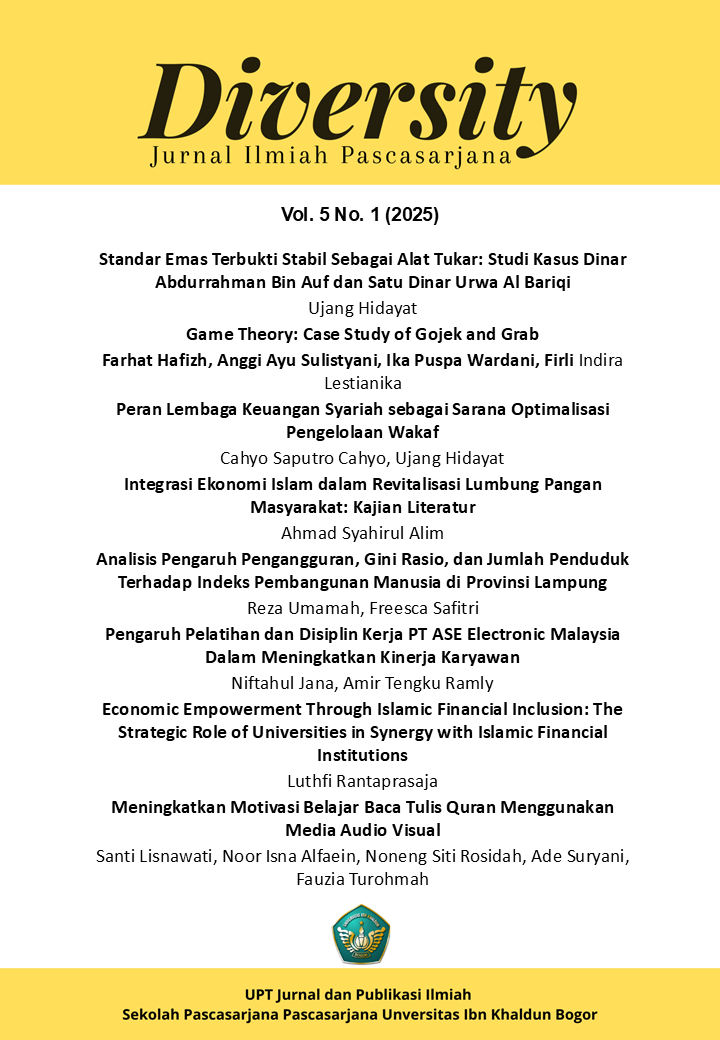Economic Empowerment Through Islamic Financial Inclusion
The Strategic Role of Universities in Synergy with Islamic Financial Institutions
DOI:
https://doi.org/10.32832/diversityjournal.v5i1.19304Kata Kunci:
economic empowerment, financial inclusion, Islamic finance, micro & small business, tridharma of higher educationAbstrak
This paper aims to examine the strategic role of universities in promoting Islamic financial inclusion as a means of economic empowerment, particularly in the Parung Panjang area of Bogor Regency. The study employs a qualitative approach, utilizing exploratory, case study, and action research methods. Data collection involves in-depth interviews with experts, academics, and practitioners in the field of financial inclusion, as well as focus group discussions and document analysis. The research explores how universities can leverage the Tridharma of Higher Education to bridge the gap between Islamic financial institutions and local micro and small businesses (MSMEs). Findings indicate that while financial literacy, accessibility barriers, and institutional coordination remain key challenges, universities can play a pivotal role in promoting Islamic financial inclusion. This can be achieved through developing financial literacy programs, conducting applied research, establishing industry partnerships, and providing direct financial assistance to MSMEs. The research highlights the significant impact of Islamic financial inclusion in enhancing community welfare. It emphasizes the importance of collaboration between higher education institutions and Islamic financial organizations to foster economic development and reduce financial disparities. This study contributes to the literature by comprehensively examining the strategic role of universities in forming, supporting, and developing Islamic financial inclusion initiatives, an area that has been less explored in previous research. It provides valuable insights into how universities can become a driving force to encourage economic empowerment through Islamic financial inclusion, potentially creating a broad positive impact on society, particularly in regions with significant economic disparities.
Referensi
Allen, F. et al. (2016). The Foundations of Financial Inclusion: Understanding Ownership and Use of Formal Accounts. Journal of Financial Intermediation, 27, 1-30. https://doi.org/10.1016/j.jfi.2015.12.003
Annur, Cindy Mutia (2023, August 8). Indonesia's economic growth is the 3rd highest in the G.20 group. Katadata Media, accessed from https://databoks.katadata.co.id/ekonomi-makro/statistik/d30e44442c3ffb7/pertumbuhan-ekonomi-indonesia-tertinggi-ke-3-di-kelompok-g20
Arfianto, A.E., & Balahmar, A.R. (2016). Community Empowerment in Village Economic Development.
Bank Indonesia (2023). Indonesia Sharia Economic Festival Report 2023. Jakarta: BI. https://www.bi.go.id/id/fungsi-utama/moneter/pengembangan-ekonomi/cetak-biru/default.aspx
Beck, T., Demirgüç-Kunt, A., & Honohan, P. (2009). Access to financial services: Measurement, impact, and policies. The World Bank Research Observer, 24(1), 119-145. https://doi.org/10.1093/wbro/lkn008
Central Bureau of Statistics of Indonesia. (2023, July 17). Gini Ratio March 2023 recorded at 0.388. BPS, accessed from https://www.bps.go.id/id/pressrelease/2023/07/17/2035/gini-ratio-maret-2023-tercatat-sebesar-0-388-.htm l
Chudzaifah, I., Hikmah, A. N., & Pramudiani, A. (2021). Tridharma of Higher Education: Synergy between Academics and Society in Building Civilization. Al-Khidmah: Journal of Community Service and Assistance, 1(1), 79-93. https://doi.org/10.47945/al-khidmah.v1i1.384
Darmawan, Agus Dwi (2024, November 10). Data 2023 PDRB ADHB per capita Bogor Regency Rp 51.38 Million. Katadata Media, accessed from https://databoks.katadata.co.id/pdb/statistik/eedd412a1210321/data-2023-pdrb-adhb-per-kapita-kabupaten-bogor-rp-51-38-juta
Demirgüç-Kunt, A., Klapper, L., Singer, D., & Van Oudheusden, P. (2015). The Global Findex Database 2014: Measuring Financial Inclusion around the World. World Bank.
Financial Services Authority (2022). National Survey of Financial Literacy and Inclusion. Jakarta: OJK. https://www.ojk.go.id
Masnita, Y., Triyowati, H., & Khomsiyah (2019). Application Of Financial Inclusions In Indonesia: A Study On Vulnerable Group. Eurasian Journal Of Economics And Finance. https://doi.org/10.15604/ejef.2019.07.01.004
National Committee for Islamic Economics and Finance (2023). Masterplan for Indonesian Islamic Economics 2019-2024. Jakarta: KNEKS. https://kneks.go.id/storage/upload/1731986199-SNLIEKSI_Low%20Res_23%20Okt.pdf
Sujud, F. A. (2024). Initiation of the Kediri Financial Services Authority in increasing sharia financial literacy and inclusion in the Kediri community. Jurnal Tanbih, 1(1), 67-77. https://doi.org/10.1234/jurnaltanbih.v1i1.001
Supriani, I., Fianto, B. A., Fauziah, N. N., & Maulayati, R. (2021). Revisiting the Contribution of Islamic Banks’ Financing to Economic Growth: The Indonesian Experience. Shirkah: Journal of Economics and Business, 6(1), 18-37. https://doi.org/10.22515/shirkah.v6i1.383
Triansyah, F. A., Gunawan, A., & Ramadhaniyati, R. (2023). Factors of Indonesia Economic Growth (2017-2022). Journal of Economic and Business Education (JPEB), 11(01), 51-65.
Widjaya, D. T., & Fasa, M. I. (2024). Islamic financial literacy: A key driver for financial inclusion and economic sustainability. Jurnal Intelek dan Cendikiawan Nusantara, 3(2), 15-29. https://doi.org/10.5678/jicn.2024.03.02.002
Ya'qub, M. (2019). Sharia Financial Inclusion for Empowering MSMEs in Indonesia. Journal of Sharia Economics.







